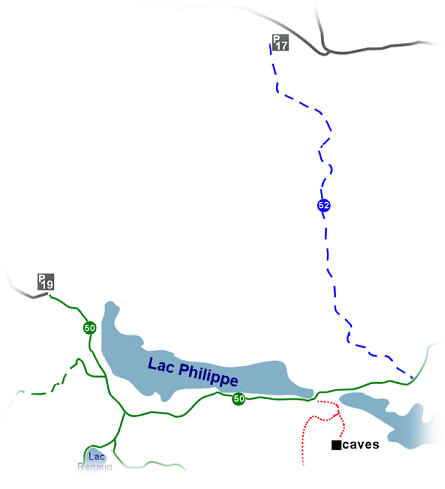
Skiing to the Lusk Caves
The Lusk Caves are located approximately one kilometre south of trail # 50, where Lac Philippe meets Lac Moussrau. This is approximately 8.5 km from P17 when using trail # 52 (blue, and somewhat difficult), or 6.5 km from P19 when using trail # 50 (green). ( scroll down for photos )
The last leg of the route between the Lusk Caves and trail # 50 is about one kilometer long. The NCC map indicates that it is both a snowshoeing and cross-country ski trail. The ski trail is classified as red (most difficult) back-country. In other words, there isn't much of a ski trail. The first two-thirds of the trail is relatively flat and not all that difficult. The last third is all about climbing, and is often too narrow for effective use of the herringbone climbing technique. So unless you really want to prove your back-country ski skills, you simply remove your skis and walk up in the area next to the trail.
As you approach the caves, you'll have to do a bit of easy rock climbing. There are several entrances to the caves. The first ones you will come across are located is a depression on the right hand side where there are two entrances opposite each other. These entrances lead to areas of the caves that are low and dark (you'll need a light), and that have very slick icy floors.
Note that the icy floors can be a real danger, especially with cross-country ski boots which offer absolutely no traction whatsoever. One of these caves has a downward slopping floor, meaning that you could easily slip and slide deeper and deeper into the cave. It is easy to see how someone could injure themselves, or worst still, become trapped towards the bottom of a dark narrow cave.
It is a little like one of those insect eating pitcher plants - where insects are lured into a plant with nectar only to discover they can no longer climb out on slippery walls. They eventually slide deeper into the plant to be devoured. Do skiers face the same fate in these caves?
Note that Gatineau Park literature indicates that people should not visit the cave during the winter without crampons and other specialized ice equipment. As a result, people rarely venture very far into the caves at the first set of entrances.
However, by following the foot path a little further you should be able to discover other entrances. One of these allows people to go 25 to 30 metres into the caves. In this area, the caves have full standing headroom as well as a number of small openings to the surface which allows in enough natural light to have a look around. Parts of the floor are ice covered, but not downward slopping. But it is still very easy to slip and injure yourself (especially when wearing ski boots), so be sure to hold on to the rock walls to keep from falling.
A Gatineau Park sign on the outside giving information about the Lusk Caves states that they are not used by hibernating bears during the winter, which is good to know. Apparently, these caves are too cold for the bears.
Obviously, these caves can be dangerous to visit during the winter. If you do go, use your judgment and exercise caution. Whatever the case, people entering the caves do so entirely at their own risk. ( see map and photos below )
|
(Click on the map for a larger view of the surrounding area of the park.)


(Photos from this trail - click on the images for larger pictures )
Photo(s) and web page, © Michael McGoldrick, 2006.
[ Return to Home Page ]
JAlbum 5.1
|





